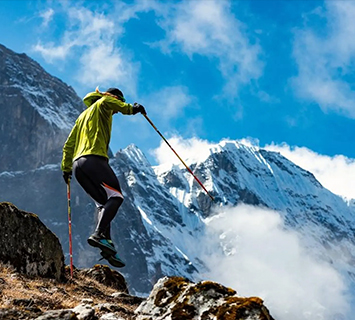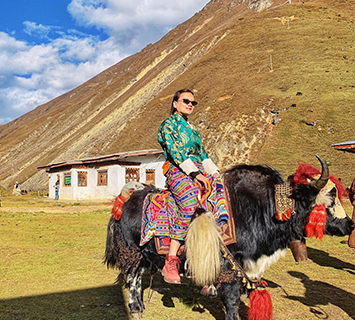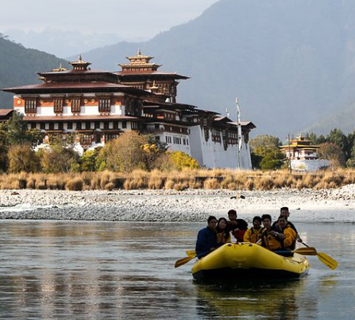Embark on the seven-day Jomolhari Base Camp trek, starting with the iconic Tiger’s Nest Monastery in Paro. Traverse picturesque valleys, weaving through rhododendron forests, and explore ancient lhakhangs and dzongs, all while enjoying cultural tours of Paro and Thimphu.
The Jomolhari Base Camp trek is a seven days trek, which ranges from the picturesque valleys of Paro and Thimphu, to the incredible mountain vistas of Jomolhari (7326m), Jichu Drake (6794m) and Tshrim Khang. Our tour begins with a visit to the stunning Tiger’s Nest Monastery, located high on the cliffside of the upper Paro valley.
We drive for around 2 hours through rice terraces, fields of millet and apple orchards to reach Shana Zampa from where we will start our trek. Sadly modern life has encroached on this route to some degree, with an electricity supply following the trail up the Paro Valley.
However, look beyond the wires and you will be treated to some amazing scenery. Throughout the trek you will be weaving your way through rhododendron forests and over glacial streams. There are many opportunities to view ancient lhakhangs, dzongs and quiet unspoilt villages, and our itinerary includes cultural tours of Paro and Thimphu.
The Air to Bhutan team will meet you at Paro airport and transfer you to your pre- trek hotel. Later in the afternoon there is the option to join a tour of the city. Once a watchtower, built to defend Rinpung Dzong during inter-valley wars of the 17th century, Ta Dzong (Fortress) was inaugurated as Bhutan’s National Museum in 1968.
It holds a fascinating collection of art, relics, religious thangkha paintings and Bhutan’s exquisite postage stamps. The museum’s circular shape augments its varied collection which is displayed over several floors. Afterwards, we will take a walk down a hillside trail to visit Rinpung Dzong, which has a long and very interesting history.
Built in 1646 by Zhabdrung Ngawang Namgyal, the first spiritual and temporal ruler of Bhutan, the Dzong houses the monastic body of Paro, the office of the Dzongda (district administrative head) and Thrimpon (judge) of Paro district. The approach to the Dzong is through a traditional covered bridge called Nemi Zam, which offers a good view of the architectural wonder of the Dzong as well as life around it. Later you will attend a pre-trek briefing with your Lead Guide to prepare you for the journey ahead.
Elevation: 2250m to 3110m to 2250m, Time: 5 hours
In the morning we will take an excursion to Taktshang Lhakhang, commonly known as ‘The Tiger’s Nest Monastery’. Undoubtedly one of the most famous of Bhutan’s monasteries, the Taktshang monastery is one of the most breath- taking temples in the world. This Buddhist place of worship is perched on a cliff- top at around 3,100m (10,000ft) above sea level.
The main temple complex was built in 1692, and is considered to be one of the holiest for the Bhutanese people. Legend has it that Guru Rinpoche, an 8th-century Indian Buddhist master, arrived here on the back of a tigress and meditated at this monastery, thus the name ‘Tiger’s Nest’. The site has been recognized as a sacred place and is now visited by all Bhutanese at least once in their lifetime.
After lunch we will visit the 7th century Kyichu Lhakhang, one of the 108 temples built in the Himalayas by Tibetan King, Songtsen Gampo. The building of this temple marks the introduction of Buddhism to Bhutan. We will then drive to Drukgyel Dzong, a ruined fortress where Bhutanese warriors fought Tibetan invaders centuries ago. In the early 1950s, Drukgyel Dzong was almost completely destroyed by fire. It is now listed in Bhutan’s Tentative List for UNESCO inclusion.
Elevation: 2250m to 2870m to 3610m, Trekking Distance: 22km, Time: 7-8 hours
After a 2 hours drive through rice terraces, fields of millet and apple orchards, we reach Shana Zampa from where we will start our trek. If the day is clear, we will have our first views of the summit of Chomolhari at the head of the valley. Soon the valley widens and we reach the army post of Gunyitsawa. This is the last stop before Tibet, with a fork in the path leading across the Tremo La (Forbidden Pass) into Tibet.
The trail follows the Pa Chhu river, ascending and descending through pine, oak and spruce forests. We enter the Jigme Dorje National Park, the largest protected area in Bhutan. After crossing a bridge to the left bank of the river, we stop for lunch. We then continue along the river, and as we climb higher, the forests are replaced with rhododendron, bamboo and ferns. We cross the river once more before reaching our campsite.
Elevation: 3610m to 4040m, Distance: 19km, Time: 5-6 hours
The path ascends, passing a small army camp and chorten (Stupa). We leave the forest behind and can fully experience the huge mountain vistas. We then follow the river above the tree line, enjoying the stunning views of the surrounding peaks – from here, the views of Jomolhari (7326m) and Jichu Drake (6794m) are superb. Lunch is served at a yak herder’s camp followed by a short walk into the valley which takes us to our campsite at Jangothang,situated below the ice- covered east face of Jomolhari at 4040m.
The base camp at Jangothang sits by an old ruined fortress, beneath Mount Jomolhari and its neighbour Jichu Drake. Today we will take an acclimatization hike to around 4500m for some great views of these two colossal mountains. Following the ‘walk high, sleep low’ principle, this hike will really help with your acclimatization.
Elevation: 4040m to 4850m to 3800m, Distance: 18km, Time: 7-8 hours
The trail follows the stream before we cross a bridge to the right bank. Now the climb starts up to the first ridge, where we can enjoy breath-taking views of Mt Jomolhari, Mt Jichu Drake and Tsrim Khang. The trail then takes us across a fairly level valley floor until the climb to the Nyele La Pass (4,850m).
From the pass we descend gradually through rhododendron forest to our campsite at Lingshi, enjoying the panoramic view of the mountain peaks and Lingzhi Dzong as we walk. The Dzong was built in 1668 to protect villages in this region from Tibetan invasion, and continues to be used as an administrative centre.
Elevation: 3800m to 4950m to 4080m, Distance: 22km, Time: 8-9 hours
Today is the toughest day of our trek, as we cross our highest pass. We begin the trek with a climb up towards a small white chorten on a ridge, then turn south into the deep Mochhu valley. The trail stays on the west side of this largely treeless valley, climbing steeply. It then crosses the river, and continues to climb steeply for two hours to Yale La pass (4,950m).
On a clear day, you can see Jomolhari, Gangchhentak, Tserim Khang and Masang Gang. We then descend alongside a stream until we reach Shodu.
Elevation: 4080m to 3710m, Distance: 16km, Time: 6-7 hours
Back below the tree line, our path follows the course of the Thimphu Chhu river, descending through rhododendron, juniper and mixed alpine forests. There are stunning views of rocky cliff faces and waterfalls along the way before we descend a steep stone staircase to the river and stop at the riverside for lunch. Then the trail takes us gradually upwards to the ruins of Barshong Dzong (3,710m), where we camp for the night.
Elevation: 3710m to 3320m to 2350m, Distance: 15km, Time: 5-6 hours
The trail descends gently through a dense forest of rhododendron, birch and conifers, then drops steeply to meet the Thimphu Chhu river. The trail runs along the left bank of the river, climbing over ridges and descending into gullies where streams run down into the river. The final stage of the trail climbs around a cliff face high above the Thimphu Chhu river, coming out onto pastureland at Dolamkencho at 3,320m. Our transport will meet us here and we will drive to Thimphu, which takes about 1 hour. Your hotel will be a welcome sight!
We start this morning in Bhutan’s capital city with a visit to the National Library, which holds a vast collection of ancient Buddhist texts and manuscripts. We will also visit the nearby Institute for Zorig Chusum, the Textile Museum, and finally Simply Bhutan, a living Museum and Studio encapsulating the cultural heritage of the Bhutanese people. (Please note some sites will be closed on weekends and public holidays).
After lunch we will leave Thimphu and drive up a series of zigzags to CheleLa Pass (3,088m) stopping briefly here to take in the view and admire the chorten, mani wall, and prayer flags which decorate the highest point on the road.
We will collect you from your hotel and transfer you to Paro Airport for your flight.

Embark on a scenic seven-day Jomolhari Base Camp trek from Paro to Thimphu. Explore iconic landmarks like Tiger’s Nest Monastery and picturesque landscapes, blending cultural tours for an immersive Bhutanese experience.

Embark on Bhutan's Laya-Gasa Trek, revealing alpine meadows, high passes, and unique Layap culture. Conclude in Gasa with a rejuvenating hot spring day, crafting an unforgettable Himalayan adventure.

Gear up for your trek with our concise checklist covering essentials like moisture-wicking layers, sturdy boots, and a reliable backpack. From sun protection to night navigation, we've got you covered for a safe and memorable adventure.
Air to Bhutan is a travel company based in Thimphu Bhutan. Although it’s a new company, we work towards catering friendly and exclusive services to our guests. Bhutan is often regarded as an exclusive travel destination, the kingdom enjoys a reputation for authenticity, serenity and a well-preserved cultural heritage and protected natural environment.
Our firm is also driven by the concept of ‘responsible tourism’. Our policies and practices ensure that all our tours are undertaken in a way that is socially & culturally acceptable and environmentally friendly. We are firmly committed to a principle wherein the environment and culture are not sacrificed at the altar of tourism. While reaping the benefits from tourism, we are also giving back to our community by part taking social corporate responsibility.